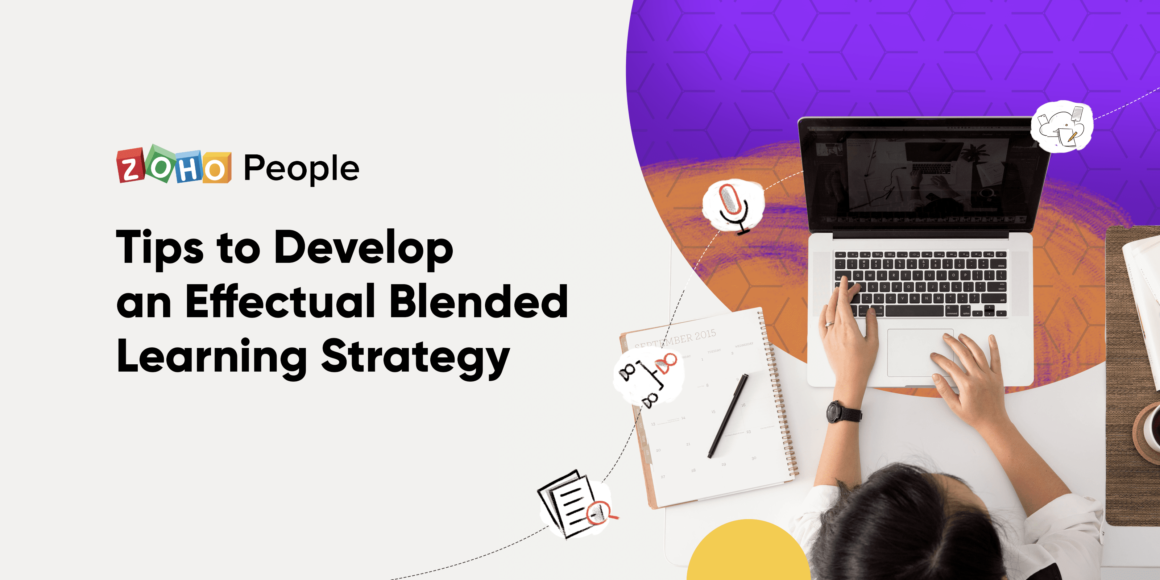- HOME
- HR insights
- 6 tips for an effective blended learning strategy
6 tips for an effective blended learning strategy
- Last Updated : August 23, 2023
- 6.3K Views
- 3 Min Read

Developing a learning culture in your business enhances employee knowledge and performance. By extension, this leads to more success for your organization. When you provide opportunities for employees to improve their skills and talents, they will feel more engaged and motivated at work. Conversely, turnover increases without access to these opportunities because it becomes easier for employees to feel that their career is stagnating. This is where blended learning can help.
Blended learning combines classroom and virtual training methods to provide the best learning experience to your employees. With blended learning, employees can access learning resources both online and offline. Often times, complex topics that need physical interaction are taught in a classroom setting, and simpler topics are taught online.
Why adopt blended learning?
With blended learning, employees can personalize a learning module according to their preference. They can learn at their own pace with online courses that can be repeated many times. This ensures a comfortable training experience that puts the learner in control. A variety of learning techniques are adopted in blended learning, so employees can grasp concepts more easily. This improves the effectiveness of your organization’s training programs. Compared to other learning techniques, blended learning requires fewer instructors, which reduces training costs. Learning materials are easily accessible, so many employees can be trained at once.
Here are some tips to develop an effective blended learning platform for your employees:
1. Understand your employees’ preferences
It’s important to understand the learning preferences of your employees before designing a blended learning program. Conduct surveys to receive their input and identify their training needs. Blend the training program according to their preference. When employees enjoy the learning modules, the training will be more effective and engaging overall.
2. Define learning goals
Defining appropriate learning goals according to employee needs is an essential aspect of blended learning. Learning objectives provide guidance to a training session and motivate your employees. Learning goals should be consistent with your organization’s objectives. Ask yourself the following questions:
What is the purpose behind the training?
What do you wish to achieve at the end of the training?
How will you measure your employees’ efforts toward these goals?
What information should be included in the training?
How will it be beneficial to your employees?
What results are you expecting?
How long should these goals take to achieve?
3. Choose the learning blend
After defining goals, choose the topics and teaching method that will help you to accomplish them. Create a content plan that clearly lists the training topics and how the topics will be taught. Go through each one and determine the appropriate teaching method—traditional or virtual classroom. Analyze the content and type of audience before choosing the learning method. For instance, baby boomers may prefer traditional classroom learning while millennials may prefer a virtual environment. If necessary, develop both classroom and online teaching methods. The basics can be taught in the classroom and additional articles, webinars, and videos can be digitally provided.
4. Encourage collaboration
Collaboration is one of the most important facets of blended learning. It allows the learners to interact with their peers and exchange ideas. This enhances the efficiency of the training program and makes learning more fun for employees. Online forums, discussion boards, video or audio meetings, chat, and webinars can all aid collaboration in a virtual classroom. Hands-on activities, group discussions, debate, projects, and scenario-based activities can be conducted in traditional classrooms to improve collaboration. This makes the blended learning course interesting and engaging.
5. Assess your training program
A proper assessment plan should help you determine if the training program was really effective and whether the learners understood the course. Developing multiple assessment methods including online quizzes, learner-to-learner assessments, branching scenarios, and group discussions can simplify the assessment process. Data analytics, which track employee performance, can also be implemented. Provide feedback on a regular basis as it can motivate your employees to excel better.
6. Receive feedback about the course
Once the training is over, ask learners to provide their feedback. This will help you adjust the course according to employee preferences. Use surveys to identify what employees liked and disliked about the course, what they think can be improved, and their ideas on how to improve it. Incorporating the learner’s perspective can have a huge impact on the efficiency of blended learning strategies.
Blended learning is a valuable teaching technique for an organization. Employees tend to process information better when both online and offline learning methods are used. The training technique can be designed according to employee preference, helping them learn better. Using HR software with a Learning Management System can help with this.
Zoho People’s Learning Management System, streamlines the entire learning process of your organization and provides a great learning experience to your employees. Blended learning, one of the prominent features of Zoho People’s LMS, combines self-paced and classroom training to help employees personalize their learning program according to their preference. Learn more about how Zoho People’s LMS works.
 Tarika
TarikaContent Specialist at Zoho People


